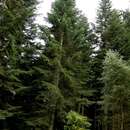Abies is a genus of between 48-55 species of evergreen conifers in the family Pinaceae, generally known as firs. They are found through much of North and Central America, Europe, Asia, and North Africa, occurring in mountains over most of the range. Nine species are native to North America. Firs are most closely related to the cedars (
Cedrus). Douglas-firs are not true firs, but are instead of the genus
Pseudotsuga. All are trees, reaching heights of 10-80 m (30-260 ft) tall with trunk diameters of 0.5-4 m (2-12 ft) when mature. Firs can be distinguished from other members of the pine family by their needle-like leaves, attached to the twig by a base that resembles a small suction cup; and by erect, cylindrical cones 5-25 cm (2-10 in) long that disintegrate at maturity to release the winged seeds. Identification of the species is based on the size and arrangement of the leaves, the size and shape of the cones, and whether the bract scales of the cones are long and exserted, or short and hidden inside the cone.
Abies wood is lightweight and decays quickly, so the primary timber uses are for pulpwood and construction (plywood). Some species have bark or leaves produce oleoresins that are used to make turpentine, varnishes, and Canada balsam (used as a slide fixative) and in the manufacture of medicinal compounds. The resin is reported to have numerous medical uses, including as an antiseptic, diuretic, expectorant, and vasoconstrictor. Various species have found widespread commercial success as Christmas trees, as celebrated in Hans Christian Anderson's famous fairy tale,
The Little Fir Tree (recited in this
YouTube clip). A few species are highly prized ornamentals. Some
Abies species are widespread in boreal forests around the globe; in lower latitudes, they are generally found at high elevations.
A. sibirica forms vast forests through northeastern Russia and Siberia and Turkestan.
A. alba, silver fir, is an important timber tree in southern and central Europe.
A. balsam is important in northeastern North America, where it forms large single-species stands or is one of the dominant species in several boreal forest types. The North American silver firs (
A. amarabilis and
A. alba) are important in the coastal rain forests of the Pacific Northwest.
A. concolor (white fir),
A. lasiocarpa (alpine fir), and
A. grandis (grand fir) are also extensive distributed in the Pacific and Mountain-Desert regions. Firs are moderately important to wildlife. The young trees are used as cover for mammals and nesting sites for birds. Deer and moose browse the leaves, sometimes extensively in winter. At least 8 species of songbirds and several mammal species eat the winged seeds. (Burns and Honkala 1990, Harlow et al. 1991, Martin et al. 1951, PFAF 2011, Wikipedia 2011)

